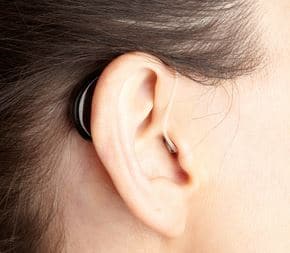Feedback is the term used to describe the “whistle” or “screeching” type of noise that hearing aids sometimes make. Feedback occurs with all audio systems, not only hearing aids. You have probably experienced feedback with public address (PA) systems and other audio systems at your school, church, or in a lecture hall. The feedback “screech” is heard when the amplified sound is picked-up by the microphone.
Various situations cause feedback. For example, it often happens when a hearing aid is set too high. Sound leaks out of the ear, re-enters the hearing aid, is amplified, and the hearing aid goes into feedback. So, be careful when you adjust the volume level. Do not use excessive amplification.
You want to be able to adjust your hearing aid to a comfortable level, without feedback. If your hearing aid feeds back when it’s set it at a comfortable level, you need the help of your audiologist. You may need a hearing aid adjustment (done with the computer), or you may need a different case (shell) on the hearing aid.
Understanding Hearing Aid Feedback: Why Does it Happen?
You’ve watched water going through a hose and into your flower beds. If the hose is not connected tightly enough to the faucet, a lot of water “leaks out” of the hose. Similarly, if there is an opening in the hearing aid, the amplified sound will “leak out” of the ear and you will experience feedback.
Let’s look at two types of hearing aids: BTEs (behind-the-ear instruments), and ITEs (in-the-ear) and consider the problem of feedback in each.
BTEs
The BTE style of hearing aid fits behind the ear and has a little tube attached to it that carries amplified sound into the wearer’s ear canal. As a general rule, BTE hearing aids have less feedback than ITEs. This is because the sound that leaks out of the ear has farther to go to reach the microphone than with an ITE. Remember, feedback happens when the sound “leaks out” of the ear and returns to the microphone. The microphone on the BTE is located behind your ear so the leaking sound is less likely to find its way back to the receiver.
In recent years, hearing aid technology has become much better at overcoming feedback problems. Feedback is controlled in two stages. First, the practitioner uses their computer to make programming adjustments to the instrument to address the problem. This is usually sufficient.
If this adjustment does not produce enough improvement, then the professional changes how the earmold or hearing aid shell is fitted in the ear canal. The goal is to keep the sound in the ear and not allow it to “leak out” of the ear canal. There are different plastics (acrylic, silicon…) and styles (vented/not vented, canal lock, domed…) that can be used. It is just a matter of finding one that works for you.
ITEs
If you wear an ITE hearing aid, i.e., an instrument that fits into your ear, the sound may leak through the vent. The vent is a physical opening that runs through an ITE aid to allow air to pass in and out of the ear canal. The purpose of vents is to make hearing aid fittings more comfortable by eliminating users’ feeling that there’s a vacuum in their ear and that their voice sounds as if they are talking in a barrel.
However, when sound leaks through the vent and causes feedback, the practitioner may need to reduce the diameter of the vent. Hearing aids come with little plastic inserts that can be used to control the vent size.
Occasionally, a hearing aid simply cannot be made to fit well and so needs to be re-made. In this situation, the hearing aid professional will take a new ear impression designed to improve the fit. Sometimes, it takes a perfect fit to eliminate feedback.
While recent advances in digital hearing aids have markedly reduced the amount of feedback, the problem continues. If you have persistent feedback, it helps to ask the question, “Why and where is the sound leaking out of my ear?”
Earwax Causing Hearing Aid Feedback?
If you get wax in your ear or if a piece of dead skin from your ear drapes across your ear canal, your hearing aid will go into feedback. The amplified sound hits the “wall” created by the wax or dead skin and the aid goes into feedback. The solution is to clean the ear.
Patience and Persistence
Feedback is a common problem, one that every practitioner has had a lot of experience dealing with. Be patient and also persistent. This problem requires some work, but it can be solved.
One last thought. People with substantial hearing loss hope that their new hearing aids can be fitted quickly and easily. Sometimes they can. However, in some cases, whether because of feedback or some other issue, it takes extra work and time to get the fitting right. In those cases, six or seven office visits may be needed rather than three or four.
Success is always possible. You can help by having extra patience.








I found it interesting how you mentioned how the way a hearing aid conforms to your ear can reduce feedback and increase comfort. My mother is very hard of hearing but she is afraid of losing her hearing more from feedback. I’ll be sure to pass this information on to her so she can rest easy knowing that she can get her hearing fixed!
I am fed up have the latest octicon mini right hearing aid but it whistles when I eat has like two people speaking at once or a echo not quite at once a aggressive sound in left ear and a hissing in right ear have called out people who sold it t me umptine time embarrassing now so depressed people don’t understand why aids don’t work think it’s yr fault